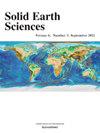Crystallisation and petrogenesis of Cenozoic alkaline basaltic lavas on the Kapsiki Plateau (Moukoulvi, Far-North Cameroon): Unveiling the mantle's heterogeneity and HIMU signature
IF 2
4区 地球科学
Q3 GEOSCIENCES, MULTIDISCIPLINARY
引用次数: 0
Abstract
The Kapsiki Plateau represents the northernmost extension of the Cameroon Volcanic Line (CVL) in West Africa. Unlike other regions of the CVL, this area is characterised by a higher prevalence of felsic and intermediate rocks compared to basaltic ones. Detailed investigations into the petrogenetic evolution of these rocks are currently limited. For this reason, Cenozoic alkaline basaltic lavas from the Kapsiki Plateau (Moukoulvi) were studied to enhance comprehension of their crystallisation process, genetic evolution of the magma, and insights into its petrogenesis and source mineralogy. The examined lavas are comparable to the mafic lavas that span the whole range of the CVL and demonstrate major and trace element characteristics similar to those seen in ocean island basalts (OIB). The major and trace element compositions suggest fractional crystallisation mainly including olivine, clinopyroxene, and Fe–Ti oxide with evidence of crustal contamination. The multi-element diagrams reveal consistency with those reported from other CVL volcanoes, displaying depletion of heavy rare earth elements (HREE) and enrichment of light rare elements (LREE), indicating an enriched source and the existence of garnet. The studied lavas have high large ion lithophile element (LILE) contents (Sr = 812–1065 ppm, Ba = 394–467 ppm) relative to high field strength elements (HFSE) (Sr/Zr = 3.97–4.94; average OIB = ∼1 Ba/La = 9.42–11.72; average OIB = 9.4). They also have Zr/Sm ratios (26.93–29.88) that are similar to the average OIB (Zr/Sm = 28). Moreover, the studied lavas exhibit elevated levels of incompatible trace elements (e.g., Rb, Pr, U, and Th), as well as higher Ta/Yb and Th/Yb ratios compared to normal OIB values, associated with a notable fluctuation in Nb/Ta and Zr/Hf ratios. The correlations between Th, La, U, and SiO2, coupled with the trend of the samples on Nb/Y vs. Rb/Y diagrams, indicate the influence of crustal contamination on the lavas' composition. The source of these lavas was a heterogeneous source with less than 4 % garnet that underwent partial melting of less than 2 %. The presence of a Pb depletion (Ce/Pb > 30) also implies that these magmas belong to the high μ (HIMU)-OIB type, attributed to lithospheric mantle metasomatism. The formation of these magmas involved partial melting of a mantle source evolving chemically and mineralogically over time with a HIMU composition at very low temperatures. Hydrous minerals, such as phlogopite or amphibole, may indicate modal metasomatism, supported by high Rb/Sr ratios or K2O high levels. Sr/Zr ratios (3.97–4.94) above OIB values (0.8–1.5) suggest Sr and Ba-rich fluid influence. Elevated Zr/Sm ratios (>28) and variations in Nb/Ta and Zr/Hf ratios point to metasomatic fluids or melts altering the mantle's composition. Therefore, the Moukoulvi lavas, like many CVL alkaline lavas, likely erupted from a metasomatized mantle source that was enriched in incompatible trace elements (Rb, Ba, Ce, Nb, and Zr). This enrichment is reflected in the elevated concentrations of these incompatible trace elements, as well as the relative enrichment in HFSE. The absence of temperature anomalies in the upper mantle beneath the CVL suggests that the magmatism originates from the lithospheric mantle source rather than a mantle plume.
喀麦隆远北卡普西基高原新生代碱性玄武质熔岩结晶与岩石成因:揭示地幔非均质性和HIMU特征
卡普西基高原是西非喀麦隆火山线(CVL)最北端的延伸。与CVL的其他地区不同,该地区的特点是与玄武岩相比,长英质和中间岩的流行率更高。目前对这些岩石成因演化的详细研究还很有限。为此,对Kapsiki高原(Moukoulvi)新生代碱性玄武岩熔岩进行了研究,以加深对其结晶过程、岩浆成因演化、岩石成因和物源矿物学的认识。所检查的熔岩可与横跨整个CVL范围的基性熔岩相媲美,并显示出与海洋岛玄武岩(OIB)相似的主要和微量元素特征。主要元素组成和微量元素组成表明,岩石中有部分结晶,主要包括橄榄石、斜辉石和铁钛氧化物,并有地壳污染的证据。该多元素图与其他CVL火山的多元素图一致,显示重稀土元素(HREE)的枯竭和轻稀土元素(LREE)的富集,表明其富集源和石榴石的存在。研究的熔岩具有较高的大离子亲石元素(LILE)含量(Sr = 812 ~ 1065 ppm, Ba = 394 ~ 467 ppm),相对于高场强元素(HFSE) (Sr/Zr = 3.97 ~ 4.94;平均OIB = ~ 1 Ba/La = 9.42 ~ 11.72;平均OIB = 9.4)。它们的Zr/Sm比率(26.93-29.88)与平均OIB (Zr/Sm = 28)相似。此外,研究的熔岩显示出不相容的微量元素(如Rb、Pr、U和Th)水平升高,以及与正常OIB值相比更高的Ta/Yb和Th/Yb比值,与Nb/Ta和Zr/Hf比值的显著波动相关。Th、La、U和SiO2的相关性,以及样品Nb/Y和Rb/Y图的变化趋势,表明地壳污染对熔岩组成的影响。这些熔岩的来源是一个不均匀的来源,石榴石少于4%,经历了不到2%的部分熔融。存在Pb亏缺(Ce/Pb >;30)表明这些岩浆属于高μ (HIMU)-OIB型,属于岩石圈地幔交代作用所致。这些岩浆的形成涉及地幔源的部分熔融,在化学和矿物学上随着时间的推移而演变,在非常低的温度下具有HIMU成分。含水矿物,如云母或角闪洞,可能表明模式交代作用,支持高Rb/Sr比或高K2O水平。Sr/Zr比值(3.97 ~ 4.94)高于OIB值(0.8 ~ 1.5),表明富Sr和富ba流体的影响。Zr/Sm比值的升高(>28)以及Nb/Ta和Zr/Hf比值的变化表明交代流体或熔体改变了地幔的组成。因此,像许多CVL碱性熔岩一样,Moukoulvi熔岩很可能是从一个富含不相容微量元素(Rb、Ba、Ce、Nb和Zr)的交代地幔源喷发出来的。这种富集反映在这些不相容的微量元素的浓度升高,以及HFSE的相对富集。CVL下的上地幔没有温度异常,表明岩浆活动来源于岩石圈地幔源,而不是地幔柱。
本文章由计算机程序翻译,如有差异,请以英文原文为准。
求助全文
约1分钟内获得全文
求助全文
来源期刊

Solid Earth Sciences
GEOSCIENCES, MULTIDISCIPLINARY-
CiteScore
3.60
自引率
5.00%
发文量
20
审稿时长
103 days
 求助内容:
求助内容: 应助结果提醒方式:
应助结果提醒方式:


